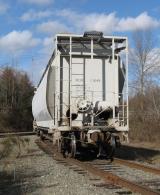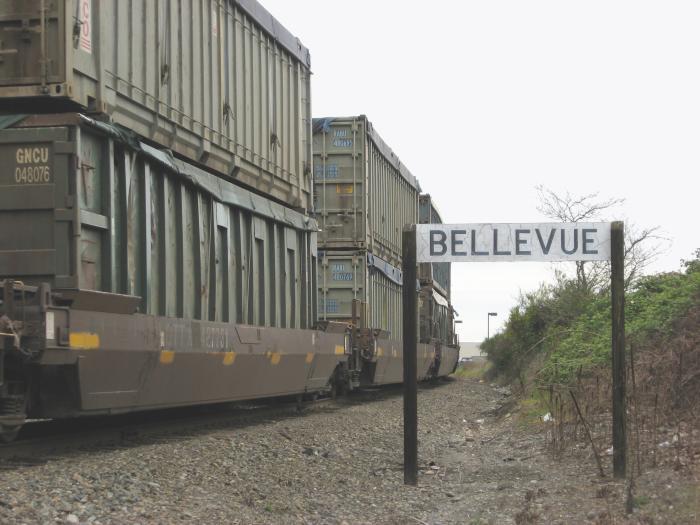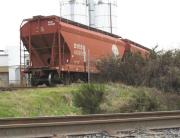The main role of the Eastside railroad has always been the transporting of freight. Although the freight business has declined in recent years, there is still a significant amount of traffic. Moreover, it is possible that the railroad's importance as a freight carrier could increase in the future if the line is kept intact.
Current Situation
 | |
| Freight car on spur in Bellevue. (click on images to enlarge and for more information) |
In addition to customers that are located along the line, the railroad currently has two additional freight roles. One is to serve as a bypass for shipments that are too large for the mile-long railroad tunnel under downtown Seattle on Burlington Northern's main north-south line. That tunnel, which was constructed in 1906 by the Great Northern Railway, is a key link in the only other north-south railroad route for hundreds of miles. Although notches were cut into both sides of its curved concrete roof a few years ago to accommodate double stack container trains, the tunnel is still too small for some extra-large items.
 | |
| Double stack container train roaring through Bellevue. |
There is also concern about a long-term loss of use of the tunnel due to a derailment and/or fire in it. Because of its age, the tunnel is not subject to current fire safety standards. Although railway tunnel fires are rare, they do happen, and the results can be devastating.2 Fire fighting in it would be extremely difficult or perhaps even impossible in the Seattle tunnel because of the lack of extra space (including walkways), lack of ventilation and lack of lighting.
There are other ways that a major earthquake could put Burlington Northern's main line out of service for an extended period. One is damage to the aging draw bridge over the Lake Washington Ship Canal north of downtown Seattle. Another is a collapse of the waterfront viaduct where it runs above the tracks.
Possible Increased Future Freight Role
In addition to these functions, it is possible that the usefulness of the Eastside railroad for freight could increase even further in the future. One reason is that the main route through downtown Seattle will become increasingly congested as a result of growing freight traffic and the planned increases in Sounder commuter train services on it by Sound Transit.
Congestion could become particularly acute on the section of the line north from Seattle to Everett. This is because that section is largely single tracked, with occasional passing sidings, in contrast to the double tracking to the south of Seattle (plus Union Pacific's additional single track parallel to it).
 | |
| Covered hopper cars at Spectrum Glass in Woodinville. |
Even in the unlikely event that fuel prices were to remain constant or decline, growing concern about climate change could result in a change in public policy to promote a shift of some freight traffic from trucks to railroads.
Mixed Transit and Freight Operation
As is typical for railroads, the Eastside railroad has the ability to accommodate substantial amounts of both transit and freight use, even with its current single-track configuration. In addition to the various benefits to the community (such as reducing truck traffic, lowering shipping costs for local industry and reducing air pollution), the provision of freight service can also be an important source of revenue and thus further add to the financial attractiveness of providing passenger service.
Moreover, the railroad could continue to accommodate the existing and new freight business even if it were converted into a light rail line at some date in the future. There are, in fact, numerous precedents for such operation around the world, including several in the U.S.3 In the case of all of the North American systems, freight service is operated at night, several hours after passenger service has ended as an extra safety precaution. No problems have been reported with any of these joint transit and freight operations.
For more information about freight service on the Eastside railroad, please see the page FAQ: Freight Service.
________
1Some sources have quoted a figure of 900 freight cars moved per year, which is less than three cars per day. This is almost certainly a gross underestimation, and it may have been created in order to make the line look less important and thus easier to abandon. Eastside Rail Now! has noticed that in recent months it is not uncommon to see trains with a dozen or more cars moving through Bellevue, and sometimes there is more than one train per day. This is consistent with the fact that some industries receive cars almost daily or several cars every few days.
2An example is the fire that occurred in the century-old Howard Street rail tunnel under Baltimore in July 2001. A train going only 18 mph derailed and burned for four days. Temperatures reached 1,500 degrees and the freight cars glowed orange from the heat. Freight traffic on the East Coast was severely disrupted because of the loss of the use of the tunnel. Fortunately, there was no structural damage, and travel through the tunnel was able to resume in six days.
3Among new light rail operations in North America that also have freight service on the same tracks are the San Diego Trolley (begun revenue operation in 1981), the O-Train in Ottawa, Canada (2001), the River Line in New Jersey (2004) and the Sprinter in Oceanside, California (scheduled for late 2007).